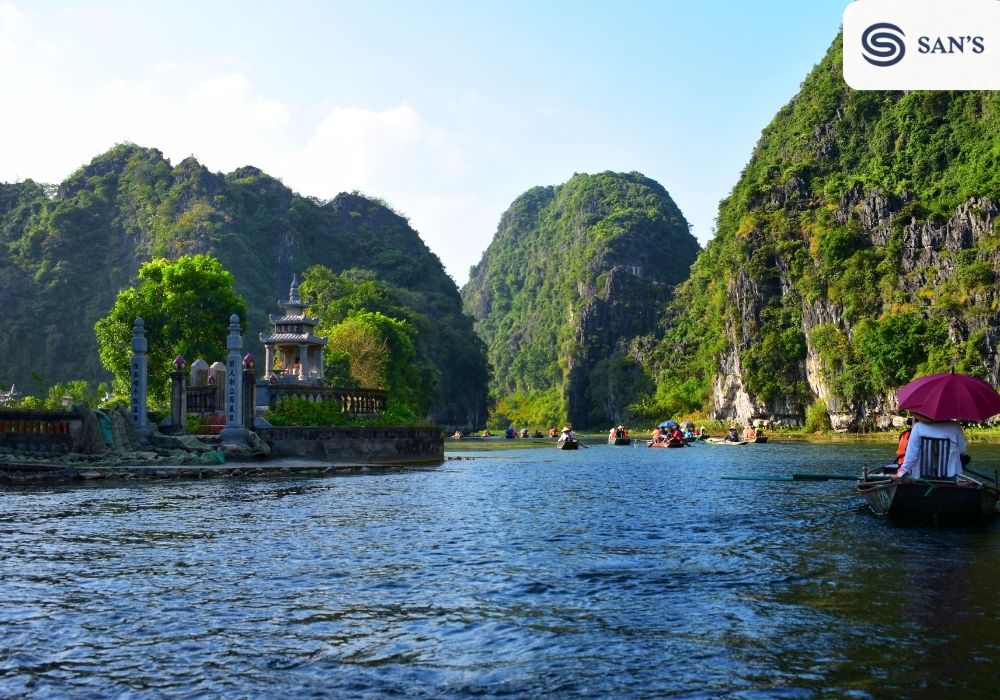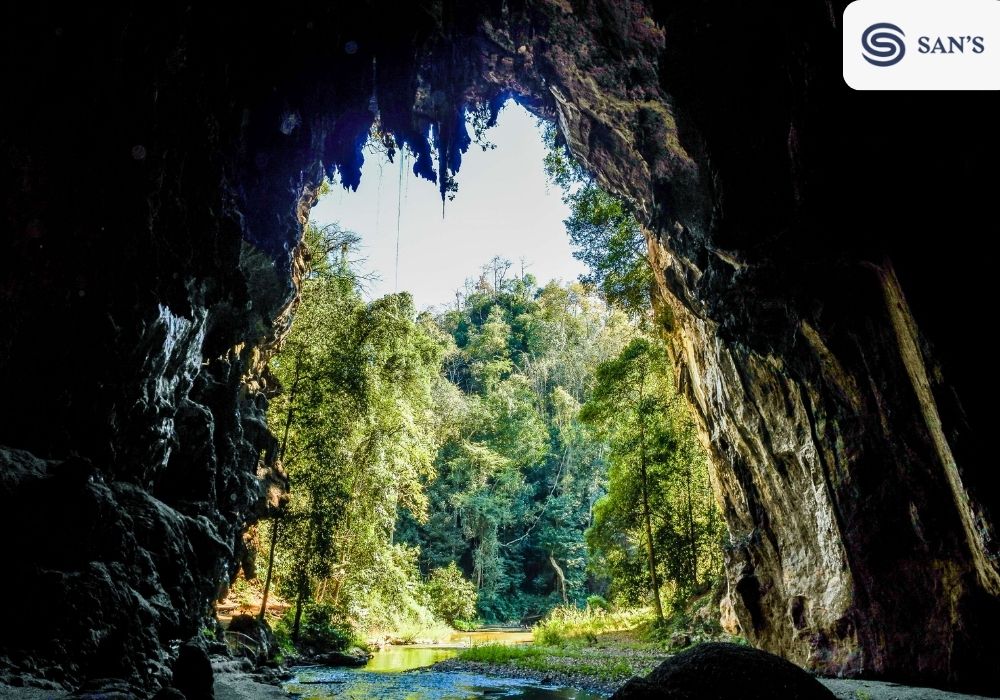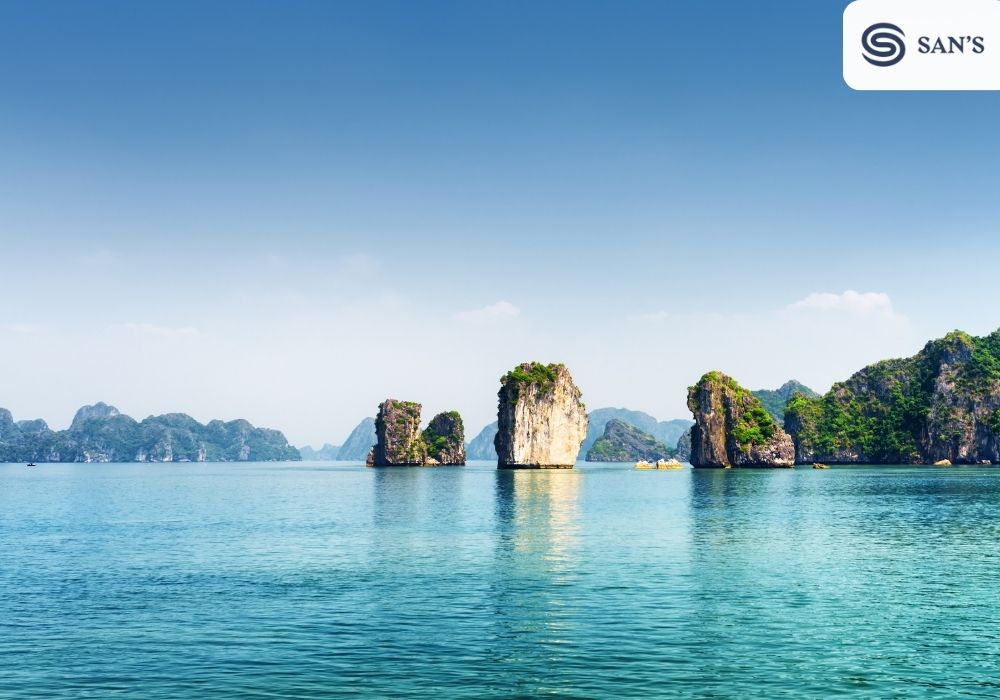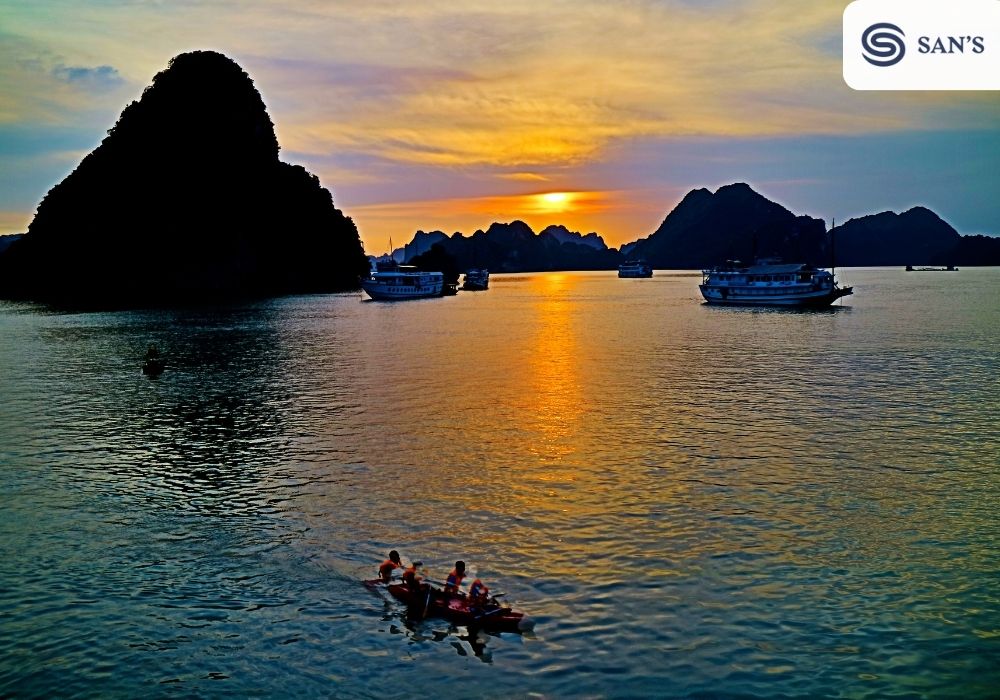Descending Dragon Bay, known locally as Halong Bay, is a natural wonder located in northeastern Vietnam. Renowned for its emerald waters and over 1,600 limestone islands, the bay forms a spectacular seascape that has captivated visitors worldwide. The name “Halong” translates to “Bay of the Descending Dragon,” a nod to a legend of a dragon descending from the heavens to aid ancient Vietnamese in defending their land. The bay’s unique landscape is believed to be the result of the dragon’s movements.
Esteemed for its extraordinary beauty and geological value, Halong Bay was declared a UNESCO World Heritage Site in 1994. This accolade not only underscores its significance but also emphasizes the importance of its conservation. Combining natural splendor, cultural lore, and global recognition, Descending Dragon Bay stands as a symbol of Vietnam’s rich heritage and natural beauty, attracting those who seek to experience its legendary charm and picturesque landscapes.
Historical and Cultural Significance

Descending Dragon Bay or Halong Bay, is deeply entwined with Vietnamese history and culture, largely due to the captivating legend that gives the bay its name. This legend tells of a time when Vietnam was under threat, and the gods sent a family of dragons to protect the land. The mother dragon and her children descended upon the earth, spitting out jewels and jade that turned into the islands and islets, forming a protective barrier against invaders. The dragons then decided to stay, giving the bay its mystical aura and name.
Historically, Halong Bay has been a cradle of ancient Vietnamese civilization with archaeological evidence dating back over 20,000 years. The bay has played a crucial role in Vietnamese history, serving as a backdrop for many pivotal events, including naval battles against invading forces. Its islands and caves have been sanctuaries for ancient people and later provided refuge for guerrillas during conflicts.
Culturally, Halong Bay has been a source of inspiration for countless artists, poets, and writers. It frequently appears in Vietnamese literature and art, symbolizing the beauty of nature and the resilience of the Vietnamese spirit. In poetry, it is often depicted as a serene, mystical, and almost otherworldly place, reflecting the nation’s deep reverence for nature. Paintings and photographs of the bay often highlight its tranquil waters and towering limestone pillars, capturing the essence of Vietnam’s natural heritage.
The lore, history, and artistic representations of Descending Dragon Bay not only celebrate its breathtaking scenery but also reflect the deep connection between the Vietnamese people and their land. This fusion of natural wonder and cultural significance makes the bay much more than a tourist destination; it’s a testament to Vietnam’s rich and enduring cultural legacy.
Geographical Wonders
Descending Dragon Bay, also known as Halong Bay, is a geographical masterpiece, showcasing some of nature’s most spectacular creations. The landscape is dominated by towering limestone karsts and islands, each rising majestically from the emerald waters of the Gulf of Tonkin. These limestone formations, shaped over millions of years by environmental conditions, have created an otherworldly scenery that leaves visitors in awe. The karsts and islands vary in size and shape, with many featuring dramatic peaks and lush vegetation, adding to the bay’s mystic and natural allure.

The unique geological formations of Halong Bay are not just visually stunning but also scientifically significant. They are the result of centuries of erosion and weathering processes, which have sculpted the limestone into various shapes, including caves, grottoes, and arches. These formations tell the story of the earth’s geological history, making Halong Bay a living museum of natural history. Among these formations, the most notable are the Dau Go Cave and the Thien Cung Cave, renowned for their impressive stalactites and stalagmites.
Biodiversity in Halong Bay is as rich as its landscapes. The area is home to a variety of ecosystems, including coral reefs, freshwater swamp forests, and mangrove forests. These habitats support a diverse range of flora and fauna, some of which are endemic to the region. The bay’s waters are teeming with over 200 species of fish and 450 different kinds of mollusks. On land, visitors might spot various species of birds, reptiles, and mammals. This rich biodiversity not only contributes to the ecological value of Halong Bay but also enhances its beauty and appeal as a destination for nature lovers and eco-tourists.
Tourist Attractions and Activities
Descending Dragon Bay, globally known as Halong Bay, offers a treasure trove of attractions and activities that cater to a wide range of interests, from serene sightseeing to adventurous excursions.
Popular Spots to Visit
- Notable Caves: The bay is famous for its stunning caves, each with unique formations and histories. Sung Sot Cave, also known as Surprise Cave, is the largest and perhaps the most impressive, known for its vast chambers and intricate stalactites and stalagmites. Dau Go Cave, characterized by its ancient feel, features remarkable stone formations resembling ancient citadels.
- Iconic Islands: Ti Top Island offers a panoramic view of the bay, especially from its summit, which is reached by a steep climb. Cat Ba Island, the largest in Halong Bay, is known for its lush forests, diverse wildlife, and hiking trails.
- Scenic Viewpoints: Climbing Bai Tho Mountain provides a breathtaking view of the entire bay. This spot is perfect for photographers and nature enthusiasts.
Activities Available
- Boat Tours: A traditional junk boat tour is a quintessential Halong Bay experience. These tours offer a leisurely way to see the bay’s best sights, often including stops at caves and islands.
- Kayaking: Paddle through the bay’s clear waters to explore hidden caves and secluded lagoons. Kayaking offers an up-close and personal experience with the bay’s natural beauty.

- Scuba Diving and Snorkeling: The bay’s clear waters are ideal for scuba diving and snorkeling, offering a glimpse into the vibrant underwater life.
Experiencing Local Culture
- Floating Villages: Visiting the floating villages, like Vung Vieng and Cua Van, provides insight into the local way of life. These villages are home to fishermen and their families who have lived on the bay for generations.
- Local Markets: Markets in the nearby mainland cities, such as the Halong Market, offer a chance to experience local culture, cuisine, and craftsmanship. Here, visitors can try local foods and purchase traditional handicrafts.
- Cultural Performances: Attend traditional music and dance performances, which are often held in the evenings on larger cruise boats or on the mainland. These performances showcase the rich cultural heritage of the region.
Travel Tips and Best Times to Visit Descending Dragon Bay
Best Times of Year to Visit Descending Dragon Bay

- Weather Considerations: The ideal times to visit Descending Dragon Bay are during the spring (March to May) and autumn (September to November). These seasons offer mild and dry weather, perfect for cruising and exploring. Summer (June to August) brings warmer, more humid conditions and occasional rain, but also lush landscapes.
- Tourism Seasons: To avoid crowds, the shoulder seasons (March to April and September to October) are recommended. Descending Dragon Bay is less busy during these times, allowing for a more serene experience.
Transportation and Accommodation
- Getting to Descending Dragon Bay: The bay is commonly accessed from Hanoi, which is about a 3-4 hour drive. Options include shuttle buses, private transfers, and seaplanes for a unique aerial view.
- Staying at Descending Dragon Bay: Accommodations range from onboard cruise ships to hotels and guesthouses in nearby areas like Halong City and Cat Ba Island. Booking in advance is advisable, especially in peak seasons.
- Cruise Options: For an immersive experience, consider an overnight cruise in Descending Dragon Bay. There are various cruises available, catering to different budgets and preferences.
Local Customs and Etiquette in Descending Dragon Bay
- Respecting Local Traditions: Be mindful and respectful of local customs, especially when visiting religious or sacred sites. Dress modestly and adhere to any specific guidelines.
- Environmental Responsibility: As a UNESCO World Heritage site, preserving the natural beauty of Descending Dragon Bay is crucial. Avoid littering and participate in sustainable tourism practices.
- Engaging with Locals: Approach locals with respect and courtesy. Knowing some basic Vietnamese phrases can enhance your interaction.
- Bargaining Practices: Bargaining is common in markets but should be done respectfully.
- Tipping Culture: While not a standard practice in Vietnam, tipping for exceptional service is appreciated, especially in the tourism and service sectors.
Conservation Efforts in Descending Dragon Bay
Challenges Facing Descending Dragon Bay
- Pollution: One of the significant challenges faced by Descending Dragon Bay is pollution, primarily caused by an increase in tourism and local industries. The influx of boats and visitors has led to water and environmental pollution, threatening the bay’s delicate ecosystem.
- Impact of Tourism: While tourism has boosted the local economy, it has also put pressure on the natural resources and environment of Descending Dragon Bay. Over-tourism can lead to habitat destruction and negatively affect the bay’s biodiversity.
Conservation Initiatives
- Governmental Measures: The Vietnamese government has implemented regulations to manage and control the number of tourists and boats in the bay, aiming to reduce environmental impact.
- Community Involvement: Local communities are engaged in conservation efforts, with initiatives aimed at educating residents and tourists about sustainable practices and environmental protection.
- Eco-Friendly Tourism: Encouraging eco-friendly tourism practices, such as responsible waste disposal, use of biodegradable materials, and participation in conservation programs, is a key focus.
How Tourists Can Contribute
- Responsible Tourism: Tourists can contribute by choosing eco-friendly tour operators, minimizing plastic usage, and respecting the natural habitat.
- Supporting Local Initiatives: Engaging with and supporting local conservation projects and community initiatives can have a positive impact.
- Raising Awareness: Tourists can help by spreading awareness about the conservation needs of Descending Dragon Bay and sharing best practices for sustainable tourism.
Role of UNESCO and Local Authorities
- UNESCO’s Involvement: As a UNESCO World Heritage Site, Descending Dragon Bay receives guidance and support for conservation and sustainable management. UNESCO’s involvement helps in raising international awareness and securing funds for preservation.
- Local Authorities’ Efforts: Local authorities are responsible for implementing regulations and policies to protect the bay, including managing tourist activities, enforcing environmental laws, and leading clean-up initiatives.
Personal Experiences and Testimonials in Descending Dragon Bay
Interviews and Quotes from Visitors
- “My first glimpse of Descending Dragon Bay was like stepping into a postcard. The tranquility of the emerald waters and the majesty of the limestone cliffs were beyond my imagination,” shared a tourist from Australia.

- A family from Canada commented, “Kayaking through the hidden caves of Descending Dragon Bay was an adventure of a lifetime. The kids were thrilled to see the diverse wildlife.”
Personal Stories Highlighting Unique Experiences
- A solo traveler from Japan recounted her sunrise experience: “Waking up early to catch the sunrise over Descending Dragon Bay was magical. The way the light played on the karsts and the calmness of the bay was surreal.”
- A couple from the UK described their cultural immersion: “Visiting the floating villages was a humbling experience. Witnessing the simplicity and resilience of the local way of life was truly eye-opening and gave us a deeper appreciation for the bay.”
Tips and Recommendations from Seasoned Travelers
- “If you’re planning to visit Descending Dragon Bay, stay on a junk boat for at least one night. It’s the best way to fully experience the beauty of the bay,” advised a frequent traveler from the USA.
- A travel blogger from Germany suggested, “Don’t miss out on the local seafood. Dining on fresh seafood while surrounded by the bay’s scenery is unforgettable.”
- “Pack light but don’t forget essentials like a good camera, sun protection, and comfortable shoes for exploring the caves and islands,” recommended a seasoned backpacker from South Korea.
Descending Dragon Bay or Halong Bay, embodies Vietnam’s mystical charm with its legendary landscapes. As a UNESCO World Heritage Site, it’s a treasure of natural beauty and cultural richness. Visitors are reminded to cherish and protect this marvel through sustainable tourism.
For an unforgettable experience in this magical bay, consider booking your tour with San Travel. Not only will you witness the enchanting allure of Descending Dragon Bay, but you’ll also enjoy the best deals and offers. Join us at San Travel for a journey that promises to be as responsible as it is memorable.



Comment (0)